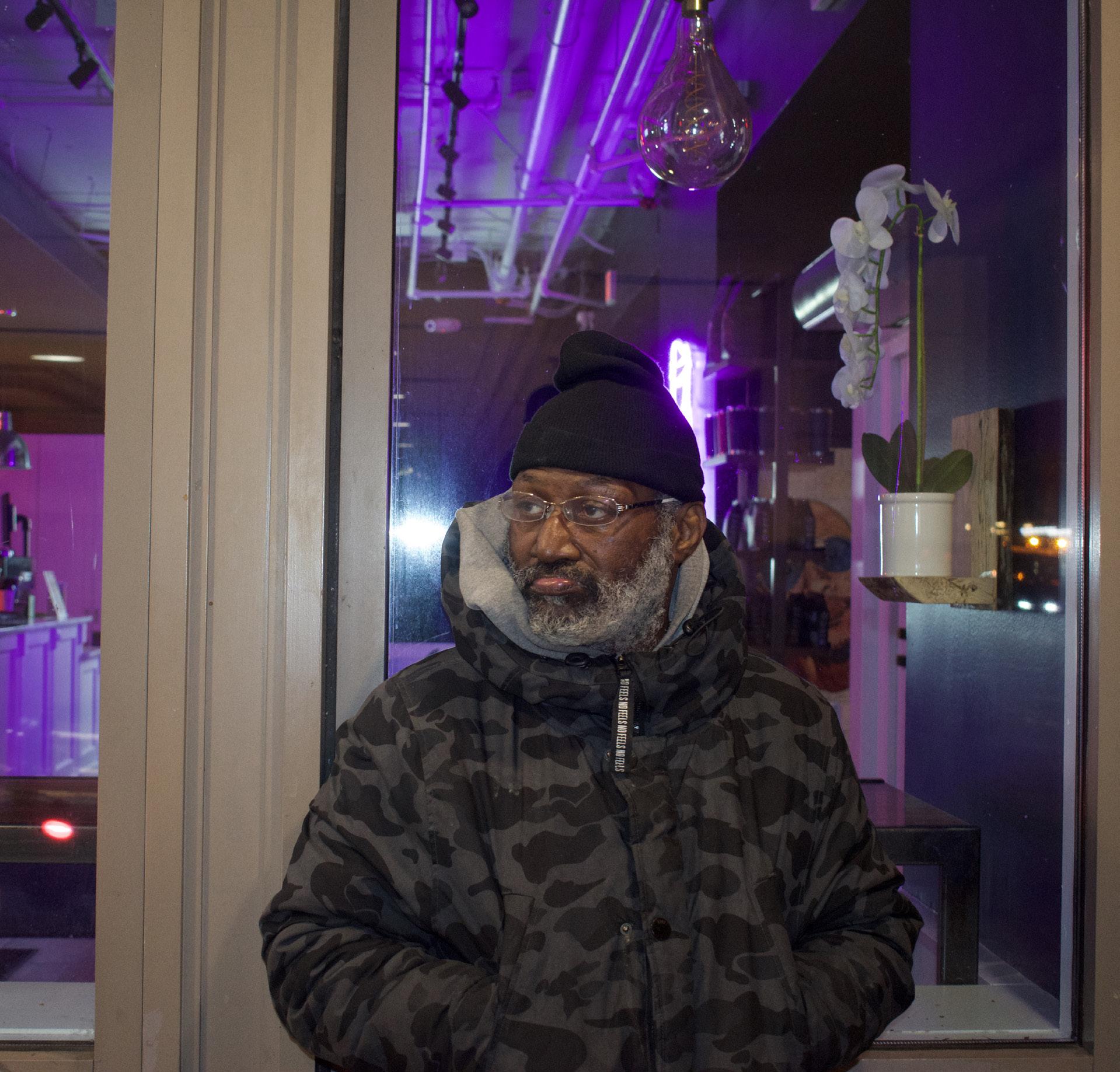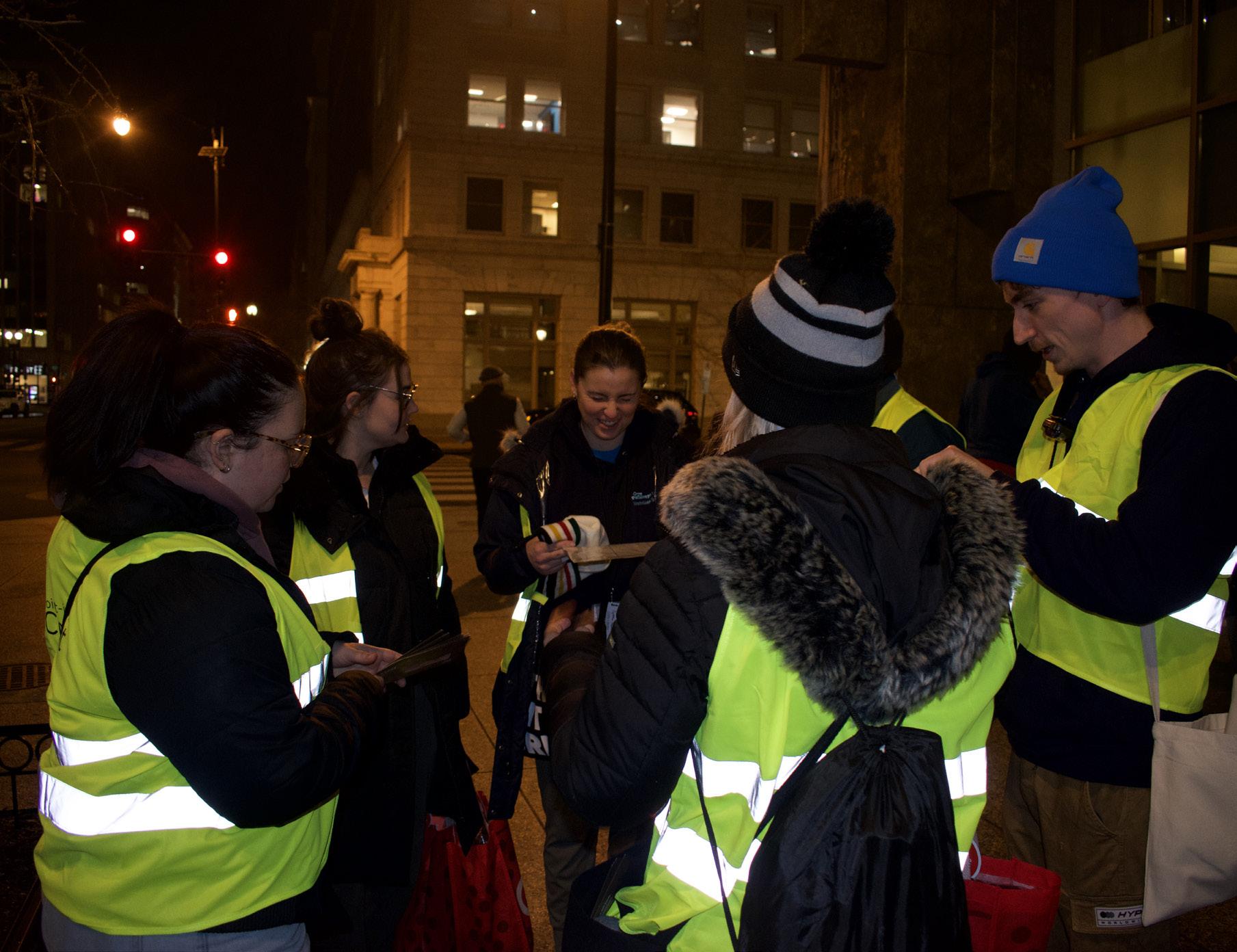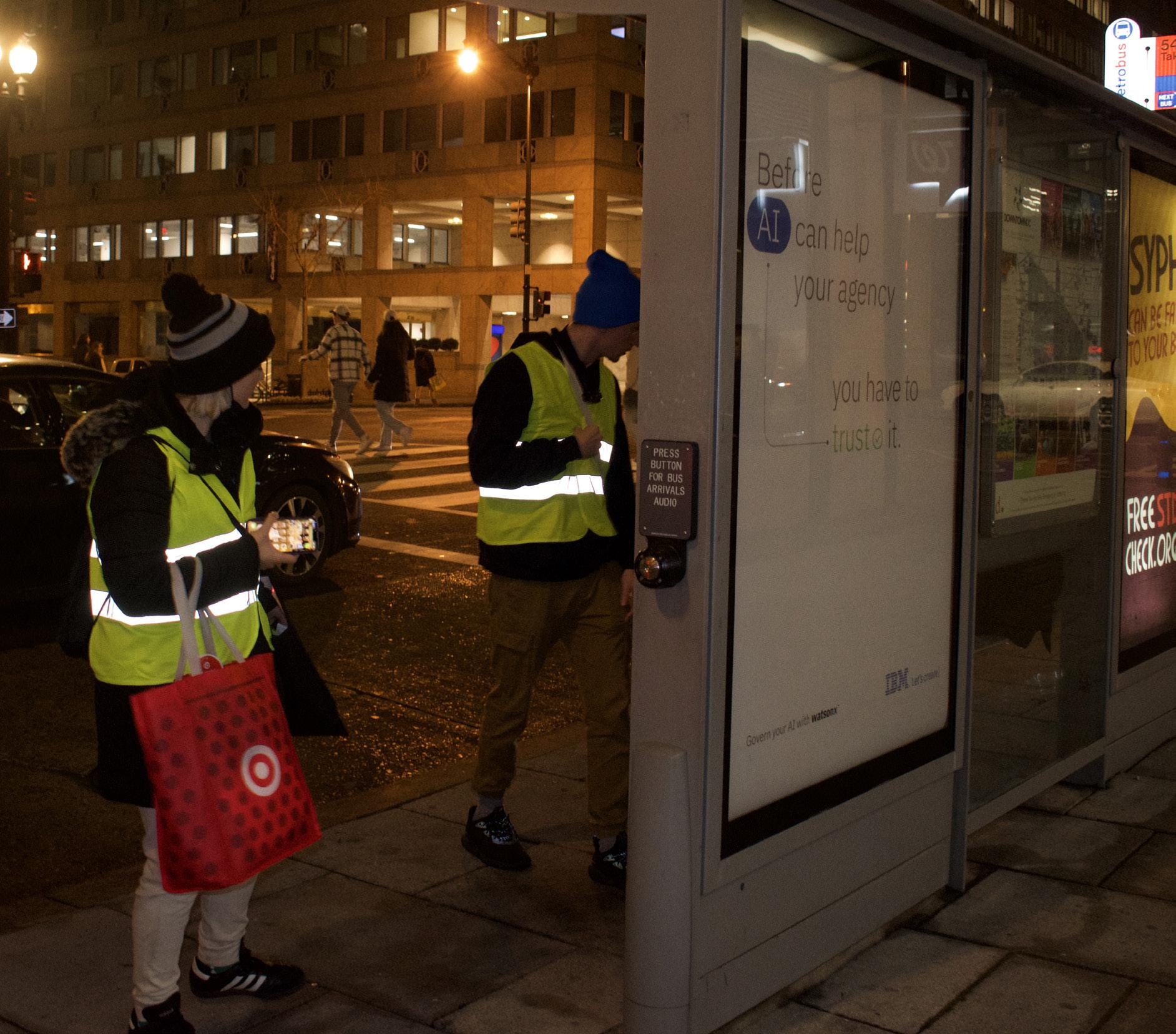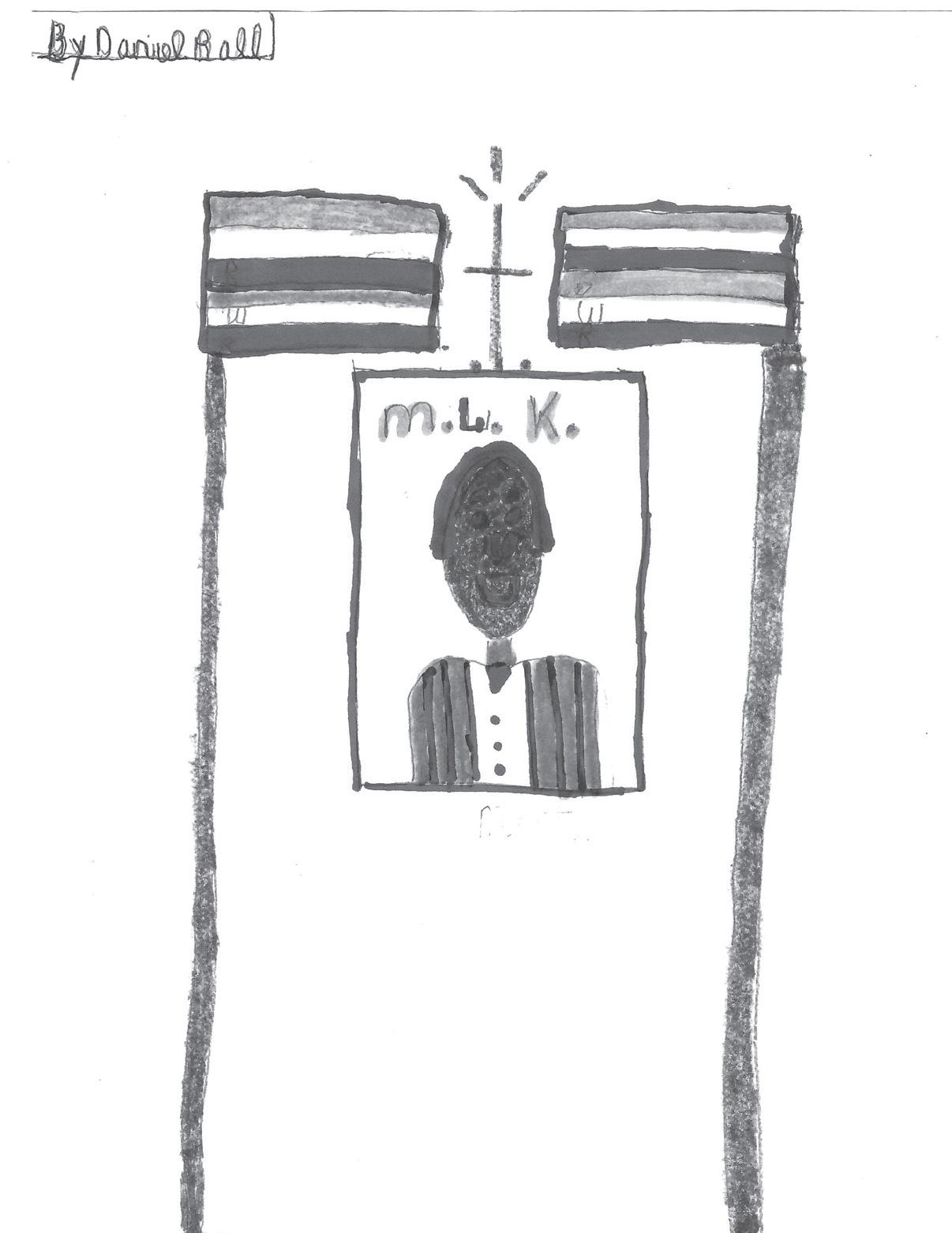



veryone at Street Sense
Media works together to support and uplift our vendor community.





veryone at Street Sense
Media works together to support and uplift our vendor community.
VENDORS

Abel Putu, Aida Peery, Al Edmonson, Akindele Akerejah, Amia Walker, Amina Washington, Andre Brinson, Andrew Anderson, Angie Whitehurst, Anthony Carney, Antoinette Calloway, Archie Thomas, Beverly Sutton, Brianna Butler, Burton Wells, Carlos Carolina, Carol Motley, Charles Armstrong, Charles Woods, Chon Gotti, Chris Cole, Conrad Cheek, Corey Sanders, Daniel Ball,
Darlesha Joyner, David Snyder, Debora Brantley, Degnon (Gigi) Dovonou, Denise Hall, Dominique Anthony, Don Gardner, Donté Turner, Doris Robinson, Earl Parker, Eric Glover, Eric ThompsonBey, Erica Downing, Evelyn Nnam, Floyd Carter, Franklin Sterling, Frederic John, Frederick Walker, Freedom, Gerald Anderson, Greta Christian, Harriet Fields, Henrieese Roberts, Henry Johnson, Invisible Prophet,
Ivory Wilson, Jacqueline “Jackie” Turner, Jacquelyn Portee, James Davis, James Hughes, Jeanette Richardson, Jeff Taylor, Jeffery McNeil, Jeffrey Carter, Jemel Fleming, Jennifer McLaughlin, Jermale McKnight, Jet Flegette, Jewel Lewis, John Alley, John Littlejohn, Josie Brown, Juliene Kengnie, Kenneth Middleton, Khadijah Chapman, Kym Parker, Laticia Brock, Laura Smith, Lawrence Autry, Levester
Green, Lu Potter, L. Morrow, Mango Redbook, Marc Grier, Marcus McCall, Mars, Martin Walker, Mary Sellman, Maurice Spears, Melody Byrd, Michael Warner, Morgan Jones, Nikila Smith, Patricia Donaldson, Patty Smith, Phillip Black, Queenie Featherstone, Rachelle Ellison, Randall Smith, Rashawn Bowser, Reginald Black, Reginald C. Denny, Ricardo Meriedy, Richard “Mooney” Hart, Rita Sauls, Robert Reed,
$2 You pay
Robert Vaughn, Robert Warren, Rochelle Walker, Ron Dudley, S. Smith, Sasha Williams, Shuhratjon Ahmadjonov, Sybil Taylor, Tonya Williams Vennie Hill, Warren Stevens, Wendell Williams, William Mack
BOARD OF DIRECTORS
Ashley McMaster, Blake Androff, Clare Krupin, Corrine Yu, Jonquilyn Hill, Matt Perra, Michael Phillips, Nana-Sentuo Bonsu, Shari Wilson, Stanley Keeve,

CHIEF EXECUTIVE OFFICER
Brian Carome DIRECTOR OF PROGRAMS
Darick Brown
DIRECTOR OF VENDOR EMPLOYMENT Thomas Ratliff
Assistance for first-time homebuyers in D.C. is in high demand.
The District’s Home Purchase Assistance Program (HPAP) ran out of funds on Jan. 11, barely four months into the fiscal year. Though the program is designed to help potential homebuyers over an entire year, the HPAP portal indicated all $26.2 million of funds for fiscal year 2024 had been claimed, DCist first reported.
D.C. residents who were hoping to buy a house with the assistance of HPAP funds will have to wait until October, the start of the new fiscal year, to apply for aid.
For decades, HPAP has helped first-time homebuyers from low-and moderate-income backgrounds with down payments. Through offering interest-free loans, HPAP has eased financial burdens for lower-income individuals and families looking to purchase a home. Repayments for these loans are deferred until the property is sold, refinanced or when the house is no longer the homeowner’s primary residence. For moderate-income earners, repayments are deferred for five years. This is critical in helping applicants, the majority of whom are Black, build generational wealth, especially in an economically and racially segregated city with a high-cost housing market.
This is not the first time need has outpaced resources for homebuyers. Last year, HPAP ran out of funds in June, three months before its funding reset. Many applicants reported feeling caught off guard, according to reporting from DCist, because there was no formal communication from the Department of
Charles Woods
Feb. 2
ARTIST/VENDOR
VENDOR
PROGRAM ASSOCIATES
Aida Peery, Chon
Gotti, Nikila Smith
VENDOR
PROGRAM VOLUNTEERS
Ann Herzog, Beverly Brown, Madeleine McCollough, Roberta Haber
□ Women's Workshop is back! Every Thursday, 1:30 - 2:30 p.m.
Housing and Community Development (DHCD) to inform them that funding was almost exhausted.
The D.C. government has long struggled with administering HPAP. The most recent shortfall in funding began when Mayor Muriel Bowser announced in 2022, the program would more than double the amount of funding applicants would be eligible to receive from $80,000 to $202,000. Yet the budget for HPAP remained the same, meaning that the number of people who could access HPAP funds was limited.
In October, DHCD introduced a new rule that capped loan assistance at 30% of the price of a house. This was presumably intended to allow more people to apply to HPAP by reducing the award any one person could receive. However, At-Large Councilmember Robert White voiced concerns that this new rule would shut off the opportunity entirely from low-income prospective homebuyers.
While the D.C. Council passed an emergency bill so applicants who had been approved for HPAP funding before this cycle can be exempted from these new rules, most Washingtonians still have to wait until this October before they can reapply for loan assistance.

□ Street Sense Media follows the federal government for weather closures. Check the office status by going to opm.gov/status. Check that Thomas has your phone number or email address so he can notify you directly.
□ Find a list of vendor announcements and other useful information just for you at streetsensemedia. org/vendor-info.
□ Street Sense Media will be closed Monday, Feb.19, for Presidents' Day.
EDITOR-IN-CHIEF
Annemarie Cuccia
EDITORIAL INTERNS
Andrea Ho, Margaret Hartigan, Nora Scully
GRAPHIC DESIGN INTERN
Bruna Costa
Erica Downing
Feb. 2
ARTIST/VENDOR
SOCIAL MEDIA INTERN
Azaria Jackson
ARTISTS-INRESIDENCE
Bonnie Naradzay (Poetry), David Serota (Illustration), Leslie Jacobson (Theater), Roy Barber (Theater), Rachel Dungan
(Podcast), Willie Schatz (Writing)
OPINION EDITOR (VOLUNTEER)
Candace Montague
EDITORIAL VOLUNTEERS
Alison Henry, Anisa Noor, Annabella Hoge, Anne Eigeman, August

Frederick Walker
Feb. 3
ARTIST/VENDOR
Ditcher, Benjamin Litoff, Cari Shane, Casey Bacot, Chelsea Ciruzzo, Dakota Bragato, Dan Goff, Elise Zaidi, Grier Hall, Jessica Webster, J.M. Acsienzo, Josh Axelrod, Kate Malloy, Kathryn Owens, Lenika Cruz, Matt Gannon,
Micah Levey, Miles Wilson, Rachel Siegal, Roman Peregrino, Ryan Bacic, Taylor Nichols, Zach Montellaro
Read this democratically elected code of conduct, by vendors, for vendors!
1. I will support Street Sense Media’s mission statement and in so doing will work to support the Street Sense Media community and uphold its values of honesty, respect, support, and opportunity.
2. I will treat all others, including customers, staff, volunteers, and fellow vendors, respectfully at all times. I will refrain from threatening others, pressuring customers into making donations, or engaging in behavior that condones racism, sexism, classism, or other prejudices.
3. I understand that I am not an employee of Street Sense Media but an independent contractor.
4. While distributing the Street Sense newspaper, I will not ask for more than $2 per issue or solicit donations by any other means.
5. I will only purchase the newspaper from Street Sense Media staff and volunteers and will not distribute newspapers to other vendors.
6. “I will not distribute copies of “Street Sense” on metro trains and buses or on private property.”
7. I will abide by the Street Sense Media Vendor Territory Policy at all times and will resolve any related disputes with other vendors in a professional manner.
8. I will not sell additional goods or products while distributing “Street Sense.”
9. I will not distribute “Street Sense” under the influence of drugs or alcohol.
10. I understand that my badge and vest are property of Street Sense Media and will not deface them. I will present my badge when purchasing “Street Sense” and will always display my badge when distributing “Street Sense.”
Following criticism over how the D.C. Department of Employment Services (DOES) handled unemployment benefits during the COVID-19 pandemic, the agency announced a change to its unemployment insurance (UI) benefits system.
The new system will allow claimants to apply for benefits in conjunction with ID.me, an online identity verification platform. DOES Director Unique Morris-Hughes believes the new system will streamline the filing process and help prevent benefits fraud, according to a press release earlier this month.
The new system will officially become operational Feb. 5, but claimants can verify their identities with 1D.me now. Once the new portal is up, claimants will be able to submit tax forms, file new UI claims, check the status of existing claims and communicate with DOES customer support using the portal.
At the start of the COVID-19 pandemic, as thousands of D.C. residents lost their jobs, some reported waiting up to 12 hours to speak to DOES representatives and months to receive benefits. In light of those issues, along with reports of at least 13,000 fraudulent unemployment claims during the same time, the District’s inspector general recommended last April that DOES make changes to its UI system. The report suggested that DOES improve the efficiency of the unemployment claim processing system, simplify the verification process and increase staff supervision.
DOES hopes the new system should do just that, according to the press release. To prevent fraud, the new UI system will use ID.me, an online platform designed to help users verify their identities.
Government agencies, including New Jersey’s Department of Labor and the Social Security Administration, use the program to process paperwork and file unemployment claims. Private businesses, including clothing and cell phone companies, also use the software to verify identities for military, teacher and health care provider discounts.
To verify identities, ID.me uses facial recognition software, which has been known to exhibit racial bias, reportedly failing to recognize people of color as well as their white counterparts, according to a United Nations report. Although ID.me was not named in the report, the U.S. inspector general last March reported concerns that facial ID systems similar to ID.me “may not result in equitable and secure access to UI benefits” due to some algorithms demonstrating racial and gender biases.
Additionally, a U.S. House of Representatives subcommittee investigation in 2022 found that ID.me subjected claimants to extremely long wait times at the height of the pandemic and exaggerated the need for its technology by providing misleading estimates of fraud, though ID.me disputed the findings.
DOES did not respond to questions by the time of publication.
When New York rolled out ID.me, its UI benefits system, some applicants filed complaints with the Better Business Bureau and the Federal Trade Commission, reporting difficulties with identity verification and poor customer service, making it hard to access benefits. Other critics argued that it is difficult for older residents and those who do not have experience with computers to navigate.
But supporters of the system, including New York, said the technology is necessary to cope with high numbers of people seeking unemployment insurance. Between March 2020 and December 2021, D.C. residents filed more than 280,000 claims for unemployment insurance benefits. Today, D.C.’s unemployment rate is 5.1%, meaning that around 36,000 people in the city are currently unemployed.
To be eligible for UI, claimants must have earned at least $1,950 in wages in the previous 12 months, lost their previous employment “through no fault of their own” and be actively looking for another job each week, among other requirements. Beneficiaries receive up to $444 per week for 26 weeks, with the possibility of 13 more weeks of eligibility in times of high unemployment.

Inspired by the children he taught at Southwest D.C.’s Amidon-Bowen Elementary School (ABES), songs ran through the mind of special education teacher Bernard Jankowski as he walked the school’s halls.
But Jankowski’s mental concerts, reflecting the joyfulness of kids playing and learning, were often drowned out by discordant, flat notes, he remembers in his recently-published memoir.
Too many of his students entered ABES not just with backpacks, but with lots of emotional baggage, Jankowski writes. And, in Jankowski’s view, the school wasn’t able to support them.
That dissonance makes Jankowski’s memoir of teaching at ABES, “Music In the Halls: the Heart and Heartbreak of Teaching at a High-Poverty School In Washington, DC” a memorable, jarring reading.
It’s D.C.’s latter-day, more muted version of Jonathan Kozol’s 1967 book “Death At An Early Age,” which recounts the author’s experience teaching in a Boston public school serving Black students. The depictions of overt racism and corporal punishment by teachers seared the conscience of Americans at that time.
Even though the most abhorrent practices that Kozol’s book recounts are thankfully not tolerated today in Boston or D.C., “Music in the Halls” should send a flashing yellow caution light to people, like this writer, who initially welcomed the changes mandated by No Child Left Behind’s testing regime and the tough, results-oriented policies advanced by then-D.C. Public Schools (DCPS) Chancellor Michelle Rhee. The book recounts how DCPS’s data-driven policies set unrealistically high expectations while ignoring the traumas affecting many students.
Jankowski, a former publishing executive and published poet, grew up in Virginia and Maryland, but his family hails from the tough working-class northeastern Pennsylvania anthracite coal region.
“There are a lot of socio-economic parallels with [largely white] Shamokin, Pennsylvania and [largely Black] Southwest and Southeast D.C. No one’s family is perfect,” Jankowski said.
In the book, Jankowski is candid about the difficulties his mother’s large family experienced, like substance abuse and legal trouble. He thinks this background helped him begin to understand the behaviors his special education students adapted to cope.
The book features short recollections of children, recounting their problems at home. One is DeAndre, whom Jankowski describes as a young person who liked trouble. DeAndre’s father was incarcerated. When “Mr. J” talked with DeAndre, urging him to change, DeAndre replied, “But how can you change?” Years after DeAndre left ABES, Jankowski heard stories about crimes DeAndre committed.
Jankowski entered ABES after Rhee departed DCPS, and many of the school’s teachers had just left due to IMPACT, an evaluation system designed to rid the school system of teachers who were allegedly underperforming. Teachers cycled through quickly and had little chance to gain experience. Because of DCPS’s turnstile system, few teachers Jankowski started with remained at ABES by the time he left.
Many ABES kids, especially those in special education classes that Jankowski taught, came not just from high-poverty backgrounds but also families beset by hunger, joblessness and parental behavioral issues such as abuse, alcohol and drug misuse, Jankowski writes. The IMPACT system failed to account for the significant challenges confronting teachers and their students, Jankowski noted. In 2018, a Washington Post article noted that despite the changes, low-income students were still less likely to have a successful teacher.
One DCPS bureaucrat, Jankowski writes, conceded after they arrived at ABES to right things, “Central Office has no idea what this is really like. They sit around all day, looking at data.”
In his book, Jankowski concedes that Rhee was attempting to solve a real issue regarding the low academic performance


of children. He asserts his belief in “rigorous instruction” to ensure students are performing at grade level and he opposes the feel-good special education instruction once a standard part of the “old” DCPS. Some notably ineffective teachers deserved termination, he writes.
But Jankowski stresses there is a role for compassion given the problems his students in special education were experiencing.
Jankowski faults the No Child Left Behind and DCPS testing regimes in use at the time for pinning labels on student performance like “below basic,” making it easy to write off the true potential of students.
“These kids were ones with difficulties but in the end they are just kids who want to succeed and belong.” Jankowski countered in an interview. “We have a real responsibility to help these young children” to achieve their potential by providing better, earlier social services and educational intervention to students.
The school’s counselors and social work crew were understaffed and overburdened. At ABES, Jankowski observed many students were noticeably underperforming in reading due to undiagnosed learning disabilities. He worked with the school psychologist to ensure those children received the necessary special help.
“We were able to test students to include in Special Ed that helped them get the services they needed,” Jankowski wrote in an email. “Once you clarify what a student needs it helps everybody."
DCPS insists teachers now receive stronger support, according to a recent fact sheet. But the problems persist. The recent spike in violent crimes committed by young people in D.C. and continued racial learning gaps demonstrate the continued need for the city to better address the true educational and emotional needs of kids from underserved neighborhoods rather than just see pupils as aggregate data.
“Music In the Halls” highlights hope at ABES too, such as grandparents trying to do right by their grandchildren. It can illuminate for many D.C. residents and aspiring educators the struggles too many children experience in our city. Now, based on his high school teaching, Jankowski is working on a new book examining the link between mental health and education. Stephen Lilienthal is a freelance writer in Washington, D.C.

Until recently, people in drug and alcoholrelated crises had few 24-hour services to turn to in the District. The main options for people who were dangerously intoxicated or experiencing an overdose were to call 911 or go to the emergency room.
This made the already difficult decision of seeking help for substance use disorder crises even more fraught, as factors like fear of legal repercussions or a lack of health insurance come into play.
Now, people have a low-barrier, 24-hour option available, free of charge. The District’s first stabilization center opened this fall, providing around-the-clock walk-in services for people experiencing substance use crises, including overdoses.
The new D.C. Stabilization Center opened after fatal overdoses in the nation’s capital hit a 10-year high in 2022.
Deaths in 2023 were on track to break that record, according to a recent report from the Office of the Chief Medical Examiner in D.C., making it one of the worst cities in the nation for overdose deaths and prompting Mayor Muriel Bowser to declare a public emergency in November.
“It’s about time that we got this place open,” D.C. At-Large Councilmember Christina Henderson said at the ribbon-cutting ceremony for the center on Oct. 30. “I’m so excited that we’re here at this point to open our first stabilization and sobering center.”
The center, located at 35 K St. NE, provides a safe, low-barrier place for people to recover from drug-and alcoholrelated crises under medical supervision. Patients can access walk-in services seven days a week, in English and Spanish. The center is run in partnership between the D.C. Department of Behavioral Health (DBH) and health care organization Community Bridges Inc.
The stabilization center can serve up to 22 patients at a time, with 16 recliners for those who need short-term care and six beds for patients who need up to 72 hours of monitoring.
Medical providers at the center can also dispense buprenorphine, a medication that helps treat opioid use disorder, reducing withdrawal symptoms and cravings.
Offering such medication around the clock will be a big help to those in recovery for substance use disorder, Johnny Bailey said, a community outreach coordinator at the D.C. harm-reduction nonprofit HIPS.
The center is staffed with nurse practitioners, registered nurses, recovery coaches, peer specialists and patient care technicians. Bailey, a trained facilitator of support and recovery meetings, said they will likely try to work with the center to host recovery meetings there as well.
Aside from the referral to long-term-care resources, center medical staff will be able to provide “more and efficient whole person care,” including rapid testing and other basic screenings, DBH Communications Director Camil Douthit said.
When someone decides they want to enter recovery, Bailey said, it often requires quick action. But, until now, few resources were available in D.C. for immediate treatment, making the barrier to recovery that much higher, especially when compared with continued substance use.
“That is something I’ve been complaining about for years now,” Bailey said. “I can get you dope in five minutes at 3 a.m., [or] I can give you a number to call at 9 a.m. on Monday if you want to get clean.”
Before the center’s opening, D.C. options for substance use disorder stabilization services were limited, Bailey said. One of the main detox facilities is at the Psychiatric Institute of Washington (PIW), where many patients are detoxing before going to prison, Bailey said.
“As an alumni, I know how that is. It’s not great,” they said. “As someone who went in there willingly, I resented being treated like a prisoner.”

Bailey hopes the new stabilization center will offer a better patient experience than detoxing at PIW, encouraging more people to use the center’s services.
Another benefit the center provides is diverting people in crisis from emergency rooms. This will help people get care faster by avoiding long wait times and alleviate some of the pressure on emergency medical service providers, Community Bridges Inc. spokesperson David Leibowitz said. The center is intended to free up space in emergency rooms but it also means patients can receive more dedicated care.
At the ribbon-cutting ceremony, Bowser said patients with acute intoxication accounted for roughly 3,800 hospital transports in the District in 2022.
“When people get the right care they have better outcomes, and the right care is not always calling 911 and sitting in an emergency room,” Bowser said at the center’s opening. “We know when it comes to substance use disorder and addiction there is no one-size-fits-all solution and we are happy that we have this facility now in our toolbox.”
At emergency rooms, providers may only have time to get a patient stabilized before they need the bed for the next patient, Douthit said.
But at the center, once patients are stabilized, staff can refer them for long-term treatment and connect them with counseling and recovery services, housing assistance and help getting back on insurance, if necessary.
“With substance use disorder, people have to choose treatment and choose recovery,” Douthit said. “We can refer people. Will they use it is up to them, but the resources are there.”
Douthit said the center saw a gradual increase in the number of people using the center and referral resources across November, the first month the center was open. DBH did not provide data on demand for services in more recent months.
“That’s a good sign for us. That’s a success knowing that those are people who aren’t on the street or aren't in their homes overdosing from the substances they’re using,” Douthit said.
The center’s location in the NoMa neighborhood was chosen in part because it’s the same location as other preexisting resources for substance use disorder, Douthit said, including a pharmacy for those without health insurance and same-day urgent care services.
Although the new center will increase access to important resources, Bailey noted there is a greater need for treatment services in areas of the city with higher overdose rates, including Ward 8.
“I have no idea why we keep putting these things as far removed from the problem as possible,” Bailey said.
At the opening of the center, Henderson said there is funding in the city budget for a second center, and she hopes to have a third open east of the Anacostia River to help treat clients in need in Wards 5, 7 and 8, where overdose death rates are highest, according to recent data.
While not a replacement for long-term treatment, advocates say stabilization and detox centers play a key role in bridging the gap between substance use and recovery.
“It's a place to sober up that isn't jail,” Bailey said. “And so whatever else I think of the rest of it, it's better than jail.”
ichael Broughton, equipped with Visa gift cards and a bright blue beanie, set out from the First Congregational United Church of Christ around 9 p.m. on Jan. 24. A D.C. Pathways to Housing program manager, Broughton was leading a team of volunteers to survey people sleeping outside in downtown D.C. for the annual Point-in-Time (PIT) Count.
MOne of the first people Broughton surveyed was Vernon, whom he met standing beneath the awning of the 13th Street entrance to the Metro Center station. As Vernon spoke to Broughton, and then to Street Sense, he kept his eyes on the nearby sidewalk. He said he was looking for someone who’d give him money for some food and water.
“I’m trying my best,” Vernon said. “It don’t seem like it, but I’m trying.”
Conducted every January, the PIT Count is a federally-mandated survey of people experiencing homelessness nationwide. Like in D.C., surveyors in cities and states around the country went out on Jan. 24, counting everyone sleeping in a shelter, on the street or in other places not intended for habitation.
It was Vernon’s first time being surveyed for the PIT Count — he got out of jail after 16 and a half years in early December. He said he could have stayed with his mom, but she’s older and he hoped he’d be alright on his own. Vernon said he’s gotten used to people ignoring him when he asks for money, so he appreciated that the survey gave him a chance to share his thoughts.
“Get out here and talk to the homeless people and see what they need and meet them where they’re at,” he said. For Vernon, that was housing assistance for people who were recently released from prison, and aid to buy basic needs, like food and water.
That’s one of the goals homeless service workers and volunteers had the night of D.C.’s PIT Count: To understand what led to people experiencing homelessness, and the kind of support they might need to find housing again.
Last year, for the first time since 2016, homelessness in D.C. increased, according to the 2023 PIT Count. Since D.C. launched its plan to end homelessness eight years ago, the number of people experiencing homelessness on any one night in D.C. has somewhat steadily decreased, largely driven by reductions in the number of families experiencing homelessness.

Despite these efforts, homelessness increased by about 12% in the District in 2023, and even more across the Washington region. Much of that increase was from people experiencing homelessness for the first time.
After a year full of changes to the homeless services system, the 2024 PIT Count offers a chance to see where homelessness in D.C. currently stands.
While D.C. has invested more resources into ending chronic homelessness by moving hundreds of people who have been on the streets for years into apartments, resources to prevent people from entering homelessness, like D.C.’s Emergency Rental Assistance Program (ERAP), haven’t met demand. The Department of Human Services (DHS), which administers most homeless services programs, is facing mid-year cuts, with an expectation that funding may again decrease next year.
Once the 2024 PIT Count results come out this spring, D.C.’s government officials will use them to decide how much the city will spend on ending homelessness over the next year.
“This is not just an interesting exercise that we’re doing, we’re doing this with people’s lives,” Christy Respress, CEO of Pathways to Housing said. “The onus is on us as a community to do something with this data.”
The PIT Count also offers a chance to see how current homeless service and prevention programs are performing, Respress said.
In fiscal year 2022, D.C. funded a record number of vouchers for individuals experiencing homelessness. Though it took years for some people to move into housing with those vouchers,
DHS Director Laura Zeilinger said at the kick-off for the PIT Count hosted by Pathways that the city helped about 1,000 people exit homelessness over the last year. But that doesn’t mean the total number of people experiencing homelessness is guaranteed to go down, as she added “yet we still see more and more people on our streets.”
Broughton said he was curious to see if there’s another increase in people experiencing homelessness for the first time, like Vernon, especially as resources like ERAP run dry. He works for Pathways at the Downtown Day Services Center, and said he was trying to help people apply for ERAP, but knew several who couldn’t.
One man came to the center, saw the portal was down, and left, not knowing that by the time he checked the website again, funds would have run out.
“I think the work Pathways does at the ground level is incredible and makes a huge difference,” Broughton said. “But the answer is always going to be more affordable and deeply affordable housing. The hope is that this type of insight leads to changes that make our job easier in the sense that we have more resources to do what we do.”
While the PIT Count is the main way jurisdictions track progress toward ending homelessness and compare efforts across the country, it isn’t perfect. The count captures people who are staying in shelters and those who sleep outside and are visible when volunteers walk by — like those staying outside metro stations, in parks or along major streets in D.C.
Broughton’s team spoke to people outside stores and sleeping in bus shelters. But those who may sleep somewhere harder to find, like in a car or abandoned building, are often
missed by the count.
SchoolHouse Connection posits this can especially lead to undercounts in family homelessness, since visible family homelessness can lead to parents losing custody of their children. The count can miss people who may spend one night or primarily stay with friends, families, or in hotels. And, there are always some people who don’t want to talk to surveyors, though they’re still included in the number.
“The reality is that I’m coming up to an individual at 10 o’clock at night and they're trying to get sleep,” Broughton said. “They might not want to have a conversation with me, which is valid. All of that combined shows where you might miss people along the way.”
In addition to sheer numbers, the PIT Count also gives insight into the specifics of the region’s homeless population. Some details don’t change year to year, Respress said, like the fact that people of color are disproportionately affected by homelessness, or that people need support addressing substance use and mental health. But this year, providers are looking out for one big change: Where people are sleeping.
Outreach providers consistently report that as the city and National Park Service have closed encampments over the past year, people who sleep outside have moved away from downtown to places harder to find, like Rock Creek Park. This can make it difficult to provide case management and to find people during the PIT Count.
“I’m interested to see where folks have moved,” said Jessie Henry, Pathways’ associate director of homeless services, adding that Pathways has seen fewer people downtown after encampment closures like at McPherson Square Park. “I’m interested to see the other areas in D.C. [where] they see the most folks.”
Pathways primarily serves the downtown area, Broughton said, and several volunteers said they were surprised at how few people were out on Jan. 24. While the hope is always that people have moved to housing, Henry’s worried people have moved to harder-to-find places.


“I think people are nervous to be downtown, because there’s no space left, and because of the closures, so it does just push people out further,” Henry said.
While the PIT results are always important, this year feels especially significant. Many resources D.C. funded to end homelessness have finally kicked in, which Respress hopes will show a decrease in homelessness as people move into housing. But she also knows the results are needed to advocate for continued funding for social services as D.C. enters a lean year.
Funding to end homelessness in D.C. is dependent on two factors. The PIT Count determines how much funding the city receives from the federal government, though federal funding is partially dependent on the results of the presidential election, Respress said. There’s also the local budget, determined by the mayor and D.C. Council. Last year, D.C. funded voucher and prevention programs below what advocates saw as their true need, and with Bowser already passing mid-year cuts on to providers, there’s a worry funding will decrease again, making it more difficult to end homelessness.
Speaking to the crowd of about 100 people gathered at the First Congregational United Church of Christ before the PIT Count began, At-Large Councilmember Robert White, who chairs the council’s housing committee, underlined this concern.
“The largest part of the progress that we have to make is on the prevention side,” he said, highlighting resources like ERAP, the Supplemental Nutrition Assistance Program, and Temporary Assistance for Needy Families, programs the council has advocated funding largely against the will of Bowser.
When the PIT results come out this spring, Pathways and other organizations will use them to advocate to keep funding programs that are helping to end homelessness.
“At the end of the day, if there aren't enough resources and people are entering the system, it means you’re going to see more people on the street,” Henry said. “People are going to need support and they’re not going to get it.”
On the road, our next stop is across the bridges and causeways to the rooftops in Miami Beach. On this trip, we attended a sold-out TEDx Talk titled “The Promise of Tomorrow.” We are continuing our mission to explore and bring back inspiring community stories.
"The Promise of Tomorrow" sounds like a title of a Sunday sermon prompting us to look forward and rethink our future. Even off the stage in casual conversation, you could feel their intense drive to magnify the good in our world.
We asked the leaders to reflect on one fundamental question: What is the number one tip they would pass on to young people? Really, the question was designed to prompt them to think about knowledge they would want to pass on to the next generations, but their insightful answers apply to all of us.
While there were more speakers, our follow-up interviews were with experts in five diverse areas: mental health, innovation, technology, the arts and engineering. With global experts agreeing that interdependence is key to solving our world's challenges, it was truly inspirational to see the progress that these movement leaders are making to lead the way.
Dr. Julie Radlauer-Doerfler, who has a PhD in public health and is the CEO of Collectively, argued out that a majority of the country’s mental health needs can be met by communities. When she asked the audience, “How many of you know someone with mental health issues?” everyone raised their hand. You could feel and hear the chatter and motivation to take action to improve the situation.
Leigh Ann Buchanan, the president of the Miami-Dade Innovation Authority, emphasized how not all innovators look the same, and neither should they. Illustrative of Buchanan’s point, I recall our recent story of how a group of homeless people designed and implemented a solution for student safety.
Ralph Echemendia, also known as the “Ethical Hacker,” spoke poignantly on the necessity of sharing knowledge, being more inclusive and reaching out to everyone. His daughter, Hennessy Echemendia, a songwriter and performer, was onstage with him. Echemendia shared how she conveys cyber security tips through a song, reaching more people than his lectures could ever do. We recall one impactful phrase: "If you think you have nothing to hide, then you won’t mind if I come inside.”
Dr. Landolf Rhodes Bararigos, an engineer and assistant
professor at the University of Miami, was asked about the effects of climate change on our mental health and if community members could be part of the solution. He answered, “We are counting on it!” He added that we can leverage the intense power of nature too. He shared how he “Adds a pebble and teaches others to add even larger pebbles… we have a collective impact together.”
Reflecting on our visit, this trip reinforced two key points. We walked away with an inspirational feeling of empowerment that the solutions are truly within us. We also realized the audience was just like us, inspired to do more, but in need of a little more detail on how to get started. Listening to the real folks in the seats, our next road trip assignment is loud and clear.
The promise of tomorrow starts now with us. Thank you and hope to see you on our next road trip stories adventure!
To view Road Trip videos, go to www.youtube.com/@ GuidedResults To go directly to TEDx, go to tinyurl.com/ TEDpromiseoftomorrow.
Ihave never been a fan of Black History Month. Our history and heritage is portrayed in ways that are more insulting than celebratory.
It’s humiliating that a race of people who have been on this planet for millions of years get one month in the darkest, coldest time of year to celebrate their heritage and culture.
While many African American voices claim to be fighting on the frontlines for racial equality, who negotiated that we have Black History Month in February? You mean there was a Black mouthpiece so desperate for acknowledgement from white society that they were willing to settle for the coldest, shortest month of the year to celebrate the achievements of African Americans?
What annoys me most is our allies in the struggle who chime in on how African Americans were held down and mistreated throughout the one month of February, then are mysteriously silent when March arrives. It’s crickets on anything that
mentions African Americans until someone gets shot by a police officer during an election year.
I stopped following Black History because nothing new or historical has been discovered.
Did history stop when Martin Luther King was killed in 1968? While these racialists honor Martin Luther King Jr., if he were alive today, would he be happy with where we are at today? Seeing people disrespect women, get high or shoot someone? James Meredith got shot for wanting to read and write, only for today's generation to call you a sell-out for being articulate.
This Black History Month, consider tuning out any more mentions of slavery, Jim Crow and boycotts. We are oversaturated with Martin Luther King and Rosa Parks memorials. Who do Black people revere, idolize, and emulate today? Say what you want about Donald Trump, but those who support him have something to champion. Who can anyone Black say they want to emulate: Hakeem Jeffries and Ayana Pressley? In our culture, we have holidays and memorials of
career criminals who fight and die at the hands of police while ridiculing people who, despite bigotry and hate, get degrees and move from the lies that Black people are forever doomed as second-class citizens, like Ben Carson and Clarence Thomas.
African Americans have done more since the day Martin Luther King Jr. was shot. Many took the challenge of having a dream and started businesses, bought stock and became entrepreneurs and investors. Some have become judges, politicians, and CEOs. You should tell your spokesman to tell the stories of those that made it so they can inspire others to get out of the hood and believe there is more than gangbanging, committing crimes or dying before you are 40.
This year, let's not recite the same tired tropes of being put down and mistreated, Why not show that, despite the game being rigged, no matter what was done to us, we never submitted to a system that was never designed for us to succeed? Did we rise to the challenge despite all we’ve been through?
Jeffery McNeil is an artist and vendor with Street Sense Media.
The United States should start by following the examples of other countries like Canada and Cuba, where health care is a right.
The Cuban government operates a national health care system, free to citizens. However, the embargo causes
painful shortages of medicine and equipment. Doctors also deal with low salaries, causing many to flee the island for better opportunities.
Canada also provides free health care for its residents. But, its system is riddled with long wait times for appointments. Nonetheless, it remains a model for other countries. Many European countries, as well as Australia and New Zealand,
offer health care for free or at a reduced cost.
We know life is the most important thing in the world and everyone should take the utmost care to live as long as they can. So, in this country, health care should be free for anyone who needs it.
Jackie Turner is an artist and vendor with Street Sense Media.


The impact of Martin Luther King Jr.’s dream walks across the world just to bring about hope for all days to come. But the dream has not come true for racial equality for all to understand and to celebrate, left unfinished just to imagine life of the worst around the world.
Meaningful creativity is the object for all to see whatever happened.
Whatever happened inspired by the hospital dream of Martin Luther King Jr. will live on for all time.
The king of the dream will never come to his end.





I believe that if he were here today, the world could somehow be a better place. He would have had many opportunities — he could have run for president, mayor or anything. He would have loved doing that. But whatever he would have decided it would have been something about helping the people of the world. But we’ll never know. All we can do is wonder.
My name is Robert Vaughn. I am a 69-year-old Washingtonian. I am currently homeless and have been diagnosed with very severe, third-stage emphysema. I became homeless about 10 months ago. Fueled by drug addiction and alcoholism, I got so far behind in rent that I was scheduled for eviction. Two days before the eviction date I packed a duffel bag with two changes of clothes, some toiletries, a bible and an extra pair of shoes. I left that apartment and embarked on a journey that, as of this point, can only be described as amazing. A journey in which God has revealed himself to me and guided me in ways that I could have only imagined. A spiritual experience, the likes of which I never even dreamed.
I entered Central Union Mission 10 months ago and enrolled in its Restoration Transformation program, an all-inclusive recovery program for people struggling with homelessness and other issues that may have contributed to that situation. In my case, drugs and alcohol.
Since being here, I’ve had to be hospitalized on three separate occasions due to my illness. There is no cure for emphysema but with medication, therapy, and possible surgery, it can be managed to a point where I can enjoy a quality of life that
One avatar
Grasps bolts of static lightning, in leather jackets
His devotees
Spark KN-95s with grinning skull
Hawaiian Boogie shirts
Twisted triskelions
Banners of AR-15s silhouette
Red, bloody, ivory Nazi
And you say the sitting
Prexy is the bad guy?

allows me to perform daily tasks and enjoy the company of my adult children.
I’m currently in the process of divorce and I have four truly amazing children. They support me at every turn. Every day isn’t peaches and cream, but in the grand scheme of things, I’m in a good space. Each day brings new challenges but God always gives me just what I need to overcome and continue on this path through recovery. I’m not necessarily where I want to be, but thank God I’m not where I used to be. Central Union Mission has proven to be the vessel that God is using to save my life. I haven’t needed anything since the day I walked through that door. When I first came here I was a bit concerned about whether my medical condition would allow me to be able to meet the requirements of the program. One day while sitting in the dining room having lunch, one of the chaplains came over, put his hand on my shoulder and said, “Robert, don’t worry about a thing. We got you.” I finished my lunch, went back into the day room and quietly cried tears of gratitude for God’s grace through this blessed place.
Here all my daily needs are being addressed. Spiritually, mentally and physically, nothing is left unaddressed. I’ve been
guided into a new personal relationship with God that has proven to be the cornerstone of my recovery. I’m provided healthy meals every day and a warm safe environment in which to heal. We’re assigned a primary counsel or spiritual advisor and social worker who leaves no stone unturned in continuing the process of restoration. I have an educational instructor who assists us with computer training, certification courses, resumes, interview techniques and much more. Through our substance abuse classes, I’ve learned so much about my addictions and how I can grow and become a whole and wellrounded individual again. This is a 16-month program so I am entering the phase of trying to obtain permanent housing. I have a monthly income, I’m disabled, I’m homeless and I’m a senior citizen. I don’t think I’ll have much difficulty in finding suitable permanent housing.
I’ve had previous periods of homelessness in the past but never really dealt with the underlying root causes of my homelessness. Today I have a new outlook. I’m developing a foundation that will withstand any trials that I may encounter. Through faith, hope, prayer and an abundance of God’s love, I’m well on my way.
INVISIBLE PROPHET
Artist/Vendor
Content warning: This piece references suicide and stalking.
There was a time in my life when I felt the loss of structural damage, suggesting freedom from inherited trauma. In recent months, I’ve realized family members and government individuals have harmed my life. Boundaries are broken, while enablers tell you confidentiality is a strict policy. I say “bullcrap!” because money and threats are everything in this life.
Government officials both where I’m from and in the District tell me every day to go kill myself. Someone who has become a stalker on behalf of my family continually posts videos on social media to let me know he has made people aware of lies by government officials and by my family. This happens because I will not be a whore professionally or bow down to those who engage daily in human trafficking.
This individual and others have taken homes from me because I’m against government officials who use people to get favors. This psychopath also spouts evil and tells me I’m no longer safe where I work. No one will protect me there.
The stalker falsely tells people I did things to him, to my family, and to others. After getting a Metropolitan Police Department emergency hospitalization form because this individual said to do it, he gets pleasure from harming me by saying “Go kill yourself.” But no one cares because the government controls everyone. You have no power and reality is weak.
Here’s the hypocrisy about “my opinion”: enablers will use my mental health to victimize me by saying “You’re paranoid, who is it, are you sure you’re not stalking him (the stalker).” These questions should never be asked because they create more harm than good. Why not take the information and investigate the one who should be investigated, if you’re not a coward? It’s a matter of believing you have power over me. You DON’T!
MARC GRIER
Artist/Vendor

Joy is when everything comes together perfectly. When you wake up to get dressed, you look in the mirror, and you’re a fashionista.
Joy is the feeling you get when you’re in love. That’s why I keep joy, joy, joy down in my heart.
I don’t understand the game of life. I do understand it is not a children’s game. To play you kind of need to know what’s happening. I shouldn’t be forced to play, but, hey, it’s such a great board… no rules no losers no winners.
we the people need day and light
we don’t need the people of the state
we need confidence and configuration
we also need what you need every day
we the people need day and light

A friend is a friend to the end. Is there such a thing as a real friend?
I don’t believe that there’s a friend anymore.
The only friend I had in my life wasn’t my friend. People I believed were friends tried to take me out. A real friend is a friend to the end.

One night while I was living on the street I encountered different realities I would like to share with my readers.
It is a reality the street is not reserved for everyone. All souls don’t need to stay on the street being homeless. And I mean that seriously.
That night while I was back from my treatment of dialysis I had nothing to eat. I drank water on an empty stomach.
I had tears in my eyes. I remembered my late mother who would never let me go hungry. While I was in my tent in front of the Epiphany Church, I noticed that a shadow came to stand in front of my tent.
If you don’t eat, you can’t sleep. All your thoughts will move too fast, thinking about trying to find something to eat.
In addition to the huge shadow, I heard three voices of three different people speaking. I couldn’t understand what they were saying, I didn’t know the language. I was scared.
I thought it would have to be the souls of people deceased either in a murder or at the hospital that night somewhere, I wasn’t sure. When you are living on the street, the fear of dying invades your thoughts at every moment. Every new day is a grace and any night is a symbol of fear and anxiety.
I would have to leave some money in my pocket to have something for someone to take. My instinct told me if he found nothing it could worsen my case.

J.K. Rowling is my inspiration to keep creating while being homeless. I read the story of her humble beginnings. It has definitely been a tough struggle for me as I canceled my selfpublished book. I had a more immediate need for my funds so it postponed my efforts and put my book on the back burner of my priorities. I still had the high inclinations to write, but not the proper space to process it all, until I made it to American University. Before that, I would quickly jot things down on scraps of paper, so I guess this book could have just as easily been named “Noted” as my publishing agent so often has said. I would spend the whole day there both to keep warm and to write and nurture my online presence. I would shortly thereafter run into Bryan Bello, but best believe, I established my presence first! I could’ve maybe garnered his and others' attention enough to reach out and work with me on my projects and material. I also ran into Professor Hawkins from the University of the District of Columbia. Hawkins greeted and welcomed me home to the university once I relocated from South Carolina State University. She had introduced me to the CaribNation editor and Candy Shannon, who was on D.C.’s only remaining jazz station at that time and was part of UDC.


Each of these nights is like a moment of prayer. I have to stay awake and be attentive to the slightest movement. Each person who passes next to my tent is a potential threat. I would sleep just two hours from 5 a.m. to 7 a.m. when the whole city woke up.
Being a homeless person puts you in permanent danger. Some people you know from nowhere can come to hurt you just for a cigarette they ask you for and you don’t have.
I remember having to check on my neighbor who was deaf, and watch over her every day and night so that any bad people do not come to hurt her. Life on the street as a homeless person is insidious. You’re open to all kinds of situations you can never predict.
You’ll want to give up on everything. Everyone will go past you as if you do not matter. Every day is scary. Where will I go to find the slightest water to wash myself, to brush my teeth before thinking about what to eat next? Those questions come into my mind.
I still remember it as if it were yesterday. Small insects like lice appeared in my clothes and my hair. I was doomed to scrape my skin every second. This is because all the rats of the whole city moved with wild lice that came into my tent.
One day, I decided to wash my clothes and saw it was all soaked with spots of blood. I even laughed that if the city arrived at my tent it should be able to compensate me because of the harm of the big rats of their city. Being a homeless
person is not easy.
Living a life as a homeless person takes away all your privileges. You are forsaken.
Sometimes you feel something is wrong. If you do not take great guard of yourself, you will get into trouble. You will be in the same clothes every day, for weeks and months.
I can’t conclude this without thanking all of the people who have never stopped helping us. With all my heart I want to thank those who despite their own situations, still come to think of us and help us.
Despite my current homeless situation, I am met with good hearts who every day support me and buy my newspapers so I can be able to get some cash to support the schooling of my three girls.
The day God grants me his blessing and I will be back in my business and find a job, I swear I will work to help also homeless people.
Thank you Street Sense Media and its partners and thank you Epiphany Church for enabling a spotlight on us. Being homeless is harder than anything.
But no matter what, you need to keep thinking positively. One day sooner or later something will change. The important rule and motto is: “Never give up, but keep it up.” Tomorrow will be handsome.
Sweetenin’ the Pot
Across
1. Marshy wetland
4. Some undergrad coll. degrees (abbr./ acron./initialism)
7. "Kapow!"
10. ____F (pre-weekend cry) (abbr./ acron./initialism)
13. Ruler's length (2 wds.) (3,4)
15. Shoreline problem
17. Behavior
18. "Doonesbury" creator
19. Dojo VIP
20. Kitchen implements
21. Flexible, electrically (abbr./acron./ initialism)
22. ___ moss
23. Never abroad
24. "Don't ___!"
26. Band performance
28. Witherspoon of "Legally Blonde"
30. NBA Finals M.V.P. Curry (2022)
33. Morally unsullied
35. Not a big-studio film
36. Ending with cash, catch or court
37. "Forget it!" (2 wds.) (2,3)
41. "Just do it," or "We try harder"
43. Amtrak's speedy D.C. to Boston train
44. Onetime SeaWorld performing orca ultimately phased out for its own wellbeing
46. "Kidding...just the opposite"
48. Scottish cap
49. Sign between Cancer and Virgo
50. Coup d'____ (Fr. for "state")
52. Backwoods male possessive pronoun
55. What a witnesses courtroom oath says, in essence (3 wds.) (1,4,3)
57. Cream-filled pastry
60. Thirty minutes later than Reveille is generally sounded (2 wds.) (5,2) (incls. abbr.)
61. "Just give me ____ minutes, okay?"(2 wds.) (1,6)
62. Formed before delivery, as concrete
63. The head of a gangland mob, say (PINK GIN anagram)
64. Ukr., once (abbr./acron./initialism)
65. Old Pontiac muscle car model (abbr./acron./initialism)
66. Small batteries
67. Ming who retired from the NBA's Houston Rockets
Down
1. Drag queen's collection
2. "___ bitten, twice shy"
3. Strip down to skinny dip (2 wds.) (3,5) (TANK EDGE anagram)
4. Like visiting teams, often
5. Seattle NBAers of yore. briefly
6. Bourbon and Desire in the Big Easy, e.g. (abbr.)
7. Midler of "Gypsy" or Davis of "All About Eve"
8. In ____ (behind on scheduled payments)
9. Italian smoker that blows off steam
in Sicily (2 wds.) (5,4) (NET AMOUNT anagram)
10. Connections between dissimilar, yet somehow related, things, people, etc. (3-3)
11. Masked man with a stick
12. Two-word sign on an occupied airplane amenity (2,3)
14. Kind of year related to budgets and finance (abbr.)
16. 1960's radical grp. (abbr,/acron./ initialism)
20. Call for a bigger poker pot... or a literal hint to the answers containing circled square groups (3 wds.) (2,3,4)
24. "Aha! Just ____ suspected!" (2 wds,) (2,1)
25. RR stop (abbr.)
27. Smokeless smoke (abbr.) (1-3)
29. Fair-hiring org. (abbr./acron./initialism)
31. Galileo's birthplace
32. Description of many a parent of a young skateboarder (2 wds.) (6,3) (THE LEGMAN anagram)
34. Major Ital. river that runs through 31-Down
38. Discovery that has prompted many a change in Great Britain? (2 wds.) (3,8)
39. Pie ___ mode
40. Thanksgiving serving
42. Endure longer than
44. Ninja Turtles' settings
45. Depression-era president or big name in household products that really suck?
47. Gov't. org. associated with a bestselling book and highly successful film about Falcon and Snowman (2 wds.) (3,3) (includes abbr./initialism)
49. What Sylvester does when he says "Thufferin' thuccotash, I'm really awethome"
51. "We ___ please" (2 wds.) (3,2)
53. Desktop pictures
54. Garden pest that leaves a telltale trail
56. Japanese computer giant (abbr./acron./ initialism)
58. Hip bones
59. "Biggest Little City" near Lake Tahoe
61. Letters before an alias
This crossword puzzle is the original work of Patrick “Mac”McIntyre. It is provided to us courtesy of Real Change News, a street paper based in Seattle, Washington. Learn more about Real Change News and the International Network of Street Papers at realchangenews.org and insp.ngo.


Housing/Shelter Vivienda/alojamiento
Case Management Coordinación de Servicios
Education Educación
Food Comida
Academy of Hope Public Charter School 202-269-6623 // 2315 18th Place NE aohdc.org
Bread for the City - 1525 7th St., NW // 202-265-2400 - 1640 Good Hope Rd., SE // 202-561-8587 breadforthecity.org
Calvary Women’s Services // 202-678-2341 1217 Good Hope Rd., SE calvaryservices.org
Catholic Charities // 202-772-4300 catholiccharitiesdc.org/gethelp
Central Union Mission // 202-745-7118 65 Massachusetts Ave., NW missiondc.org
Charlie’s Place // 202-232-3066 1830 Connecticut Ave., NW charliesplacedc.org
Christ House // 202-328-1100 1717 Columbia Rd., NW christhouse.org
Church of the Pilgrims // 202-387-6612 2201 P St., NW food (1-1:30 on Sundays only) churchofthepilgrims.org/outreach
Community Family Life Services 202-347-0511 // 305 E St., NW cflsdc.org
Community of Hope // 202-232-7356 communityofhopedc.org
Covenant House Washington 202-610-9600 // 2001 Mississippi Ave., SE covenanthousedc.org
D.C. Coalition for the Homeless 202-347-8870 // 1234 Massachusetts Ave., NW dccfh.org
Father McKenna Center // 202-842-1112 19 Eye St., NW fathermckennacenter.org
Health Care Seguro Employment Assistance Assitencia con Empleo
Food and Friends // 202-269-2277 (home delivery for those suffering from HIV, cancer, etc) 219 Riggs Rd., NE foodandfriends.org
Clothing Ropa Transportation Transportación
Legal Assistance Assistencia Legal Showers Duchas
Foundry Methodist Church // 202-332-4010 1500 16th St., NW foundryumc.org/idministry
Identification services
Friendship Place // 202-364-1419 4713 Wisconsin Ave., NW friendshipplace.org
Georgetown Ministry Center // 202-338-8301 1041 Wisconsin Ave., NW georgetownministrycenter.org
Jobs Have Priority // 202-544-9128 425 2nd St., NW jobshavepriority.org
Loaves & Fishes // 202-232-0900 1525 Newton St., NW loavesandfishesdc.org
Martha’s Table // 202-328-6608 marthastable.org
2375 Elvans Road SE
2204 Martin Luther King Ave. SE
Miriam’s Kitchen // 202-452-8926 2401 Virginia Ave., NW miriamskitchen.org
My Sister’s Place // 202-529-5991 (24-hr hotline) mysistersplacedc.org
N Street Village // 202-939-2060 1333 N St., NW nstreetvillage.org
New York Avenue Shelter // 202-832-2359 1355-57 New York Ave., NE
Patricia Handy Place for Women 202-733-5378 // 810 5th St., NW
Samaritan Inns // 202-667-8831 2523 14th St., NW samaritaninns.org
Laundry Lavandería
Samaritan Ministry 202-722-2280 // 1516 Hamilton St., NW 202-889-7702 // 1345 U St., SE samaritanministry.org
Sasha Bruce Youthwork // 202-675-9340 741 8th St., SE sashabruce.org
So Others Might Eat (SOME) // 202-797-8806 71 O St., NW some.org
St. Luke’s Mission Center // 202-333-4949 3655 Calvert St., NW stlukesmissioncenter.org
Thrive DC // 202-737-9311 1525 Newton St., NW thrivedc.org
Unity Health Care 3020 14th St., NW // unityhealthcare.org
- Healthcare for the Homeless Health Center: 202-508-0500
- Community Health Centers: 202-469-4699
1500 Galen Street SE, 1500 Galen Street SE, 1251-B Saratoga Ave NE, 1660 Columbia Road NW, 4414 Benning Road NE, 3924 Minnesota Avenue
NE, 765 Kenilworth Terrace NE, 555 L Street SE, 3240 Stanton Road SE, 3020 14th Street NW, 2700 Martin Luther King Jr. Avenue SE, 1717 Columbia Road NW, 1313 New York Avenue, NW BSMT Suite, 425 2nd Street NW, 4713 Wisconsin Avenue NW, 2100 New York Avenue NE, 2100 New York Avenue NE, 1333 N Street NW, 1355 New York Avenue NE, 828 Evarts Place, NE, 810 5th Street NW
Washington Legal Clinic for the Homeless 1200 U St., NW // 202-328-5500 legalclinic.org
The Welcome Table // 202-347-2635 1317 G St., NW. epiphanydc.org/thewelcometable
Whitman-Walker Health 1701 14th St., NW // 202-745-7000 2301 MLK Jr. Ave., SE // 202-797-3567 whitman-walker.org
For further information and listings, visit our online service guide at StreetSenseMedia.org/service-guide
Server
Pacifica Senior Living // 46555 Harry Byrd Highway, Sterling, VA
Part-time
Prepare tables with special attention to sanitation, present restaurant menus and help customers select food/beverages, take and serve orders, deal with complaints or problems with a positive attitude.
REQUIRED: N/A
APPLY: tinyurl.com/pacificasenior
Waiter/server
The Twisted Crab // 15535 Emerald Way, Bowie, MD
Part-time, full-time
Help customers select food/beverages, take and expedite orders, answer questions or make recommendations for complementary products, collaborate with other restaurant servers and kitchen/bar staff, complete side work around restaurant, deal with complaints or problems with a positive attitude, issue bills and accept payment.
REQUIRED: N/A
APPLY: tinyurl.com/bowiecrab
Stocker
Costco // 2441 Market St. NE
Full-time
Stock and organize merchandise in the warehouse.
REQUIRED: N/A
APPLY: tinyurl.com/costcostocker







